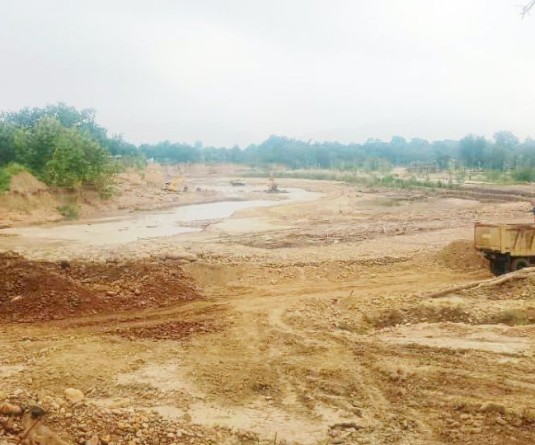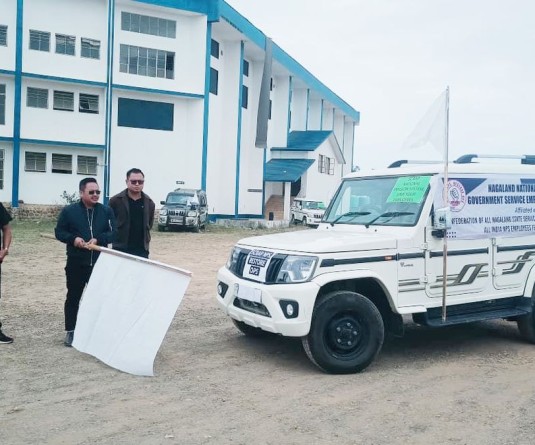(Left) The fence made of brick and cement, seen here, around the oil well is to protect the overflow of oil into the surrounding areas as well as to prevent tampering that could lead to further accidents. The Government of Nagaland sanctioned Rs. 60 Lakh last year for fencing 23 oil wells in Changpang and Tssori villages in Wokha. (Right) One of the oil rigs that ONGC abandoned in 1994 that continues to leak crude oil in the summer and rainy seasons due to natural or induced pressure. (Morung Photos)

Morung Express News
Dimapur | April 15
The Nagaland state government, after 19 years of the oil spill, has taken steps to curb the flow of crude oil from the abandoned oil wells to areas beyond the wells in Changpang and Tssori villages in Wokha district. Through a sanctioned amount of Rs. 60 Lakh, the Government of Nagaland has fenced 23 leaking oil rigs and wells, completed in January this year. The Gauhati High Court, last year, also directed the Government of Nagaland’s Commissioner Secretary, Health & Family Welfare, to conduct a ‘health Impact study’ on Tssori and Changpang villages to assess the damage done by the crude petroleum spill. The progress of that is unknown thus far.
Between 1981 and 1994, the Oil and Natural Gas Corporation Limited (ONGC) drilled 31 oil wells in Changpang and Tssori. Of these, three remained incomplete. Of the functional wells, 21 produced oil while two produced natural gas. In the 13-year period, given a license to explore 18 kilolitres of crude oil on trial, the ONGC managed to take out 1.02 million metric tons. This is an official estimate; the real profit ONGC made could be more. The state government was compensated with Rs. 33.83 Crore, of which Rs. 67 Lakh was given to the landowners.
Having under compensated the rightful owners of land and resources, and over extracted, the ONGC was asked to leave. Without plugging the wells, they left. Since then, mostly in summer and when it rains, crude oil oozes out of these wells/rigs, resembling toothpaste squeezed out of a tube. The oil, once out, seeps down to as far as 5.2 meters into the soil polluting even the ground water that people consume—farming practices, grazing, vegetation suffer.
On an average, the oil and natural gas is located 3 Km beneath the earth’s surface connected by pipes. Nine of these wells used to have an established active outflow while three were subdued. Six of these continue to have a strong outflow, and can form a pool of sludge (crude oil + water) around the head.
But the spillage is not uniform. Some of the wells that did not leak before have started leaking lately. Reasons for this upsurge, say experts, are myriad. One of them is natural pressure through rain and heat or tectonic plate movement of the Earth. Another is the oil extraction process underway 100-200 Km away, in Assam, which induces pressure. Now that there is a tube connecting oil and natural gas beneath the earth to its surface, any pressure leads to the substances leaking out.
Once penetrated, there are two ways to deal with the oil and gas beneath: to exploit it or enclose the oil head with what the industry calls a “christmas tree”. The ONGC failed to do the latter, leading to a PIL filed against them that demands compensation worth Rs. 1000 Crore for the damage caused by the two decades of oil spill.
The fencing of the oil wells with brick and cement walls by the government is temporary. The Directorate of Geology and Mining, Nagaland, has plans that could redeem the polluted soil around through a natural process called Phytoremediation (that reclaims the soil with the help of vegetation like thatch and thorny creepers found in the Changpang area, catalyzed by a chemical codenamed ‘zipper’). But the plan is a castle in the air as the issue remains in “no man’s land” with neither ONGC nor the state government taking responsibility of the episode. Meanwhile, 11 zones in the 11 districts of Nagaland have been opened up for bids from oil firms to re-start oil exploration activities in Nagaland.


.jpg)



